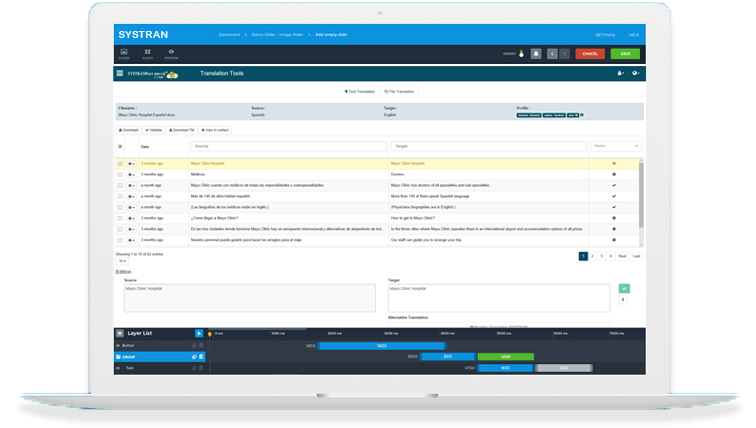SYSTRAN LANGUAGES
Over 140+ Language Pairs Available and more being added.
SYSTRAN Languages
SYSTRAN has been the leader in translation technology for over 50 years.
SYSTRAN has been developing language translation software over the past years using the best linguistic practices and resources, allowing them to provide the highest quality translations.
Their unique combination of linguistic knowledge and advanced neural (artificial intelligence) technology sets them apart in the marketplace.
Professionals can translate content with their own tone of voice and terminology, ensuring accurate and personalized translations.

FAQ's for Languages
SYSTRAN provides two dialects: Castilian Spanish and International Spanish.
The International Spanish is a unique blend of dialects and works great for Mexican and more Latin American locals. With Ai technology the software is trained on content from multiple regions so it has learned to detect the dialect.
You can easily localize your translations by building custom dictionaries, translation memories or creating your own AI Model.
Differences in Modes of Address:
Within the Spanish language, variations in addressing individuals exist between Castilian Spanish, primarily spoken in Spain, and Latin American Spanish. In Castilian Spanish, the informal second-person plural pronoun used is “vosotros,” while in Latin American Spanish, it is “ustedes.” Additionally, the usage of formal “usted” and informal “tú” can differ between these two dialects.
Grammar: Significant variations in application of past tenses between Castilian and Latin American Spanish. Castilian Spanish commonly employs the present perfect tense to discuss recent past events, while Latin American Spanish tends to favor the preterite tense for similar contexts.
Vocabulary: Distinct differences in vocabulary emerge between these two dialects, particularly with regard to regional slang and idiomatic expressions. Vocabulary choices can significantly vary, reflecting cultural and regional nuances.
Leismo and Object Pronoun Usage Patterns:
A notable language feature, “leismo,” occurs in Castilian Spanish, where the pronoun “le” is often used in place of “lo” or “la” when referring to direct objects. This practice is less prevalent in Latin American Spanish.
Regional Differences:
Both Castilian Spanish and Latin American Spanish possess regional variations within their respective dialects. These regional differences can significantly influence aspects such as pronunciation, vocabulary, and grammar.
You can easily localize your translations by building custom dictionaries, translation memories or creating your own AI Model.
SYSTRAN uses Brazilian Portuguese dialect.
The Brazilian Portuguese dialect is more widely used than European Portuguese and our most requested dialect. Brazilian Portuguese is a bit different in how it sounds, the words used, and the way sentences are put together compared to European Portuguese, which is spoken in Portugal. However, even with these differences, people who speak one dialect can usually understand the other.
You can easily localize your translations by building custom dictionaries, translation memories or creating your own AI Model.
Mandarin and Cantonese are spoken dialects of the Chinese Language. There are only two forms of written Chinese, Simplified and Traditional.
If you are translating documents, you need to determine if you need Traditional or Simplified. SYSTRAN includes both in our list of languages.
Simplified Chinese characters were introduced back in the 1950s and 1960s in an effort to promote literacy for both native and non-native speakers
- Traditional Chinese: More brush strokes per character, more complex.
- Simplified Chinese: Over 2,000 characters have been simplified by reducing the number of strokes per character or by combining characters from the Traditional form to create a new character.
Simplified Chinese characters are made by one of the following three methods.
- Reduce the number of brush strokes of a character.
- Combine complex characters into a simpler character.
- Establish a new meaning to a traditional character with a small number of strokes.
Simplified Chinese is used predominantly throughout mainland China, as well as Singapore and Malaysia.
Traditional Chinese is used in Hong Kong, Taiwan, and Macau.
Translate English to/from the following:
North American
Dialects:
American English / Canadian English / Canadian French
Castilian Spanish / International Spanish (more North American, Mexican and Latin America) / Brazilian Portuguese,
- Arabic
- Bengali
- Bulgarian
- Catalan
- Chinese (Traditional)
- Chinese (Simplified)
- Croatian
- Czech
- Danish
- Dutch
- Estonian
- Finnish
- French
- Georgian
- German
- Greek
- Hebrew
- Hindi
- Hungarian
- Icelandic
- Indonesian
- Italian
- Japanese
- Korean
- Latvian
- Lithuanian
- Malay
- Norwegian
- Pashto
- Persian
- Polish
- Portuguese
- Romanian
- Russian
- Serbian
- Slovak
- Slovenian
- Spanish
- Swahili
- Swedish
- Tagalog
- Tamil
- Thai
- Turkish
- Ukrainian
- Urdu
- Vietnamese
- Welsh
Translate Spanish to/from the following:
- English
- French
- German
- Italian
- Korean
- Portuguese
Translate French to/from the following:
- Arabic
- Chinese (Traditional)
- Chinese (Simplified)
- Dutch
- English
- German
- Greek
- Italian
- Portuguese
- Spanish
Translate Korean to/from the following:
- Chinese (Traditional)
- Chinese (Simplified)
- English
- French
- German
- Indonesian
- Japanese
- Russian
- Spanish
- Thai
- Vietnamese
Translate German to/from the following:
- English
- French
- Italian
- Korean
- Portuguese
- Spanish
Translate Russian to/from the following:
- English
- Korean
Mono-Directional Lanuages:
- Albanian to English
- Punjabi to English
- Dari to English
- Somali to English
- Tajik to English

Need Help Choosing The Right Product?
Our phones are answered by a live person! Our team has over 20 years experience with providing translation solutions. Reach a real person for both sales and support.
